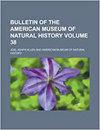Mammalian Diversity and Matses Ethnomammalogy in Amazonian Peru Part 3: Marsupials (Didelphimorphia)
IF 5.1
2区 环境科学与生态学
Q1 BIODIVERSITY CONSERVATION
Bulletin of the American Museum of Natural History
Pub Date : 2019-06-14
DOI:10.1206/0003-0090.432.1.1
引用次数: 25
Abstract
This report is the third in our monographic series on mammalian diversity and Matses ethnomammalogy in the Yavari-Ucayali interfluvial region of northeastern Peru. Based on taxonomic analysis of specimens collected in the region, we document the occurrence of 19 species of marsupials in the genera Caluromys, Glironia, Hyladelphys, Marmosa, Monodelphis, Metachirus, Chironectes, Didelphis, Philander, Gracilinanus, and Marmosops. Our principal taxonomic results include the following: (1) we provide a phylogenetic analysis of previously unpublished mitochondrial DNA (mtDNA) sequence data for Caluromys that supports the reciprocal monophyly of all currently recognized species in the genus but reveals substantial heterogeneity in one extralimital taxon; (2) we explain why Marmosa constantiae is the correct name for the southwestern Amazonian taxon previously known as Mar. demerarae, and we diagnose Mar. constantiae from Mar. rapposa, a superficially similar species from southern Peru, eastern Bolivia, and central Brazil; (3) we explain why Mar. rutteri is the correct name for one of the Amazonian species currently known as Mar. regina, and we restrict the latter name to the transAndean holotype; (4) we recognize Metachirus myosuros as a species distinct from Met. nudicaudatus based on morphological comparisons and a phylogenetic analysis of new mtDNA sequence data; and (5) we name a new species of Marmosops to honor the late Finnish-Peruvian naturalist Pekka Soini.Of the 19 marsupial species known to occur in the Yavari-Ucayali interfluve, 16 have been recorded in sympatry at Nuevo San Juan, the Matses village where we based most of our fieldwork from 1995 to 1999. We explain why we believe the marsupial species list from Nuevo San Juan to be complete (or nearly so), and we compare it with a species list obtained by similarly intensive fieldwork at Paracou (French Guiana). Although Nuevo San Juan and Paracou are 2500 km apart on opposite sides of Amazonia, the same opossum genera are present at both sites, the lists differing only in the species represented in each fauna. We briefly discuss current explanations for spatial turnover in species of terrestrial vertebrates across Amazonian landscapes and provide evidence that the upper Amazon is a significant dispersal barrier for marsupials.Marsupials are not important to the Matses in any way. In keeping with their cultural inattention to mammals that are inconspicuous, harmless, and too small to be of dietary significance, the Matses lexically distinguish only a few kinds of opossums, and they are not close observers of opossum morphology or behavior.秘鲁亚马孙地区哺乳动物多样性和Matses民族哺乳动物学。第3部分:有袋动物
本报告是我们关于秘鲁东北部亚瓦里-乌卡亚利河间地区哺乳动物多样性和马蒂斯民族哺乳动物学专题系列的第三篇。通过对该地区标本的分类分析,发现该地区有袋类动物共19种,分别为Caluromys、Glironia、Hyladelphys、Marmosa、Monodelphis、Metachirus、Chironectes、Didelphis、Philander、Gracilinanus和Marmosops。我们的主要分类结果包括以下内容:(1)我们对Caluromys先前未发表的线粒体DNA (mtDNA)序列数据进行了系统发育分析,该数据支持该属中所有目前公认的物种的相互单系性,但揭示了一个界外分类单元的实质性异质性;(2)我们解释了为什么Marmosa constantiae是亚马逊西南地区以前被称为Mar. demerarae的分类群的正确名称,并且我们将Mar. constantiae从Mar. rapposa中诊断出来,Marmosa constantiae是秘鲁南部、玻利维亚东部和巴西中部的一个表面相似的物种;(3)我们解释了为什么marr . rutteri是目前已知的marr . regina的一个亚马逊物种的正确名称,我们将后者的名称限制为跨安第斯山脉的全型;(4)我们认为肌赘元胞是一个不同于Met的物种。基于形态比较和新mtDNA序列数据的裸尾龙系统发育分析(5)我们为一种新的狨猴命名,以纪念已故的芬兰-秘鲁博物学家佩卡·索伊尼。在Yavari-Ucayali间隙已知的19种有袋类动物中,有16种是在新圣胡安(Nuevo San Juan)被记录下来的,Matses村是我们1995年至1999年大部分野外工作的基础。我们解释了为什么我们认为Nuevo San Juan的有袋类物种列表是完整的(或接近完整的),并将其与在Paracou(法属圭亚那)通过类似的密集田野调查获得的物种列表进行了比较。虽然新圣胡安和帕拉库在亚马逊河两侧相距2500公里,但在两个地点都有相同的负鼠属,只是在每个动物群中所代表的物种不同。我们简要讨论了目前对亚马逊地区陆生脊椎动物物种空间迁移的解释,并提供证据表明亚马逊上游是有袋动物的重要传播屏障。无论如何,有袋动物对马蒂斯来说都不重要。由于他们的文化对不显眼的、无害的、太小而没有饮食意义的哺乳动物不重视,马泰人在词汇上只区分了几种负鼠,他们对负鼠的形态和行为也没有密切的观察。
本文章由计算机程序翻译,如有差异,请以英文原文为准。
求助全文
约1分钟内获得全文
求助全文
来源期刊
CiteScore
7.90
自引率
2.90%
发文量
4
审稿时长
>18 weeks
期刊介绍:
The Bulletin, published continuously since 1881, consists of longer monographic volumes in the field of natural sciences relating to zoology, paleontology, and geology. Current numbers are published at irregular intervals. The Bulletin was originally a place to publish short papers, while longer works appeared in the Memoirs. However, in the 1920s, the Memoirs ceased and the Bulletin series began publishing longer papers. A new series, the Novitates, published short papers describing new forms.

 求助内容:
求助内容: 应助结果提醒方式:
应助结果提醒方式:


